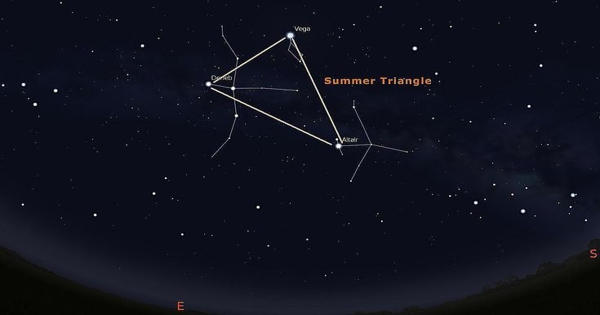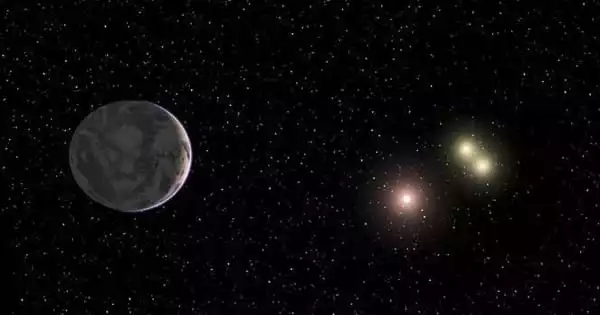Altair, also called α Aquilae, α Aql, is the brightest star in the constellation of Aquila. It is only 16.8 light-years from Earth, making it one of our closest stellar neighbors. At least 2 features of the star make it distinctive. For one thing, Altair needs only 10 hours to spin once on its axis, in contrast to roughly a month for our sun. It has 1.79 times the Sun’s mass and an estimated radius between 1.63 and 2.03 times that of the Sun. With a temperature in the range between 6,900 K and 8,500 K, it is 10.6 times more luminous than the Sun.
Altair is the twelfth-brightest star in the night sky and one of the closest stars to Earth, at a distance of only 16.7 light-years.
It is the twelfth brightest star in the night sky. In the east after dark on these July evenings, look near the horizon for Altair, the brightest star in the constellation Aquila the Eagle. It is in the G-cloud—a fog of gas and dust known as an interstellar cloud. This is the bottom star of the Summer Triangle; that is, it’s the last of these three bright stars to ascend over the horizon. Altair is an A-type main sequence star with an apparent visual magnitude of 0.77. It is one of the vertices of the Summer Triangle (the other two vertices are Deneb and Vega). It is the nearest of the three stars. It is also the coolest and least luminous. It appears brighter than Deneb, but not quite as bright as Vega. This star is 16.7 light-years from our sun and is one of the closest stars visible to the unaided eye. It is 16.7 light-years (5.13 parsecs) from the Sun and is one of the closest stars visible to the naked eye.
- Apparent magnitude: 0.76
- Distance from Earth: 16.7 light-years
- Color: White
- Mass: 1.83 M☉
- Radius: 1.79 R
- Constellation: Aquila
- Right Ascension: 19h 50m 47s
- DeclinationL +08° 52′ 06”

Altair rotates rapidly, with a velocity at the equator of approximately 286 km/s. This appears to be on the main sequence, where stars still burn hydrogen in their cores, but it’s almost twice the Sun’s size and mass. This is a significant fraction of the star’s estimated breakup speed of 400 km/s. It’s possible that Altair has begun to utilize helium in the core, and therefore could be on the way towards becoming a subgiant star. A study with the Palomar Testbed Interferometer revealed that Altair is not spherical, but is flattened at the poles due to its high rate of rotation. Other interferometric studies with multiple telescopes, operating in the infrared, have imaged and confirmed this phenomenon.
Altair spins rapidly, with a velocity at its equator of about 286 km/s. While the Triangle can be viewed during seasons other than summer, it’s fun to go looking for it in July or August because it is very high up in the sky, close to the zenith. Altair has one of the fastest known rotational speeds – 210 kilometers per second (131 miles per second) and so completes at least one rotation in about 10.4 hours. It is a very fast spinner, with a rotational velocity of about 286 km/s, or 71.5 percent of its estimated breakup speed (400 km/s). By comparison, the rotational speed of Sol is only 25.4 days at its equator. Its rotational period is about 8.9 hours. For comparison, the Sun’s rotational period is a little more than 25 days. As a result of the rapid spinning, the star probably has the shape of a flattened ellipsoid, where the equatorial diameter was estimated to be 14 percent greater than the polar diameter in 2001.
Information Source:
















